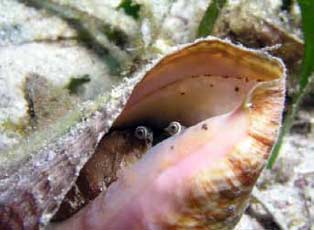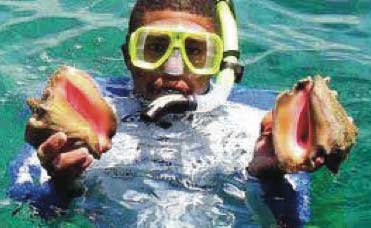|
|  Queen Conch
Today, mollusks not only exist in the ocean, but in fresh water as well as on land. Marine mollusks generally use gills to breathe while some terrestrial mollusks have lungs. A main characteristic of mollusks is that they have no internal skeleton. The shell serves as an exoskeleton to protect the soft bodied against the outside world. The shell is actually only loosely attached and does not provide support or rigidity to the animal. In fact, some mollusks including octopus and squid do not utilize the shell at all. The shell is generally composed of calcium carbonate, which is secreted by the outer surface of the mantle (covering) of the shell as the creature ages. The composition can be thickened, enlarged and repaired, but does not play a part in the metabolism of the animal. When the mollusk dies, its shell is the one part that typically remains intact. Chances are you have come across thousands of shells that have wash up on the seashore during your last trip to the beach. The shell of a mollusk grows periodically, not continuously, like that of a human child. The upper surface of the shell is formed by tissue at the mantle edge, while inner layers are secreted by all parts of the mantle surface. Therefore, growth takes place in two directions: Parallel to the edge– growth in size, and at right angles of the surface-growth in thickness. This varying growth process assures that no two species are exactly the same. A shell formation can produce new structural elements (folds or tubercles) and as growth continues, these irregularities can produce what is known as an ornament or sculpture on the upper surface of the shell. Mankind has always been astonished by the intricate design and varying color patterns of shells. The color and design of the shell is mainly dependent on the diet of the animal. In warmer waters where a variety of food sources are abundant, you will find thousand of species in all shapes, sizes and especially colors. In colder waters where food sources are typically the same, you will find mostly darker shells lacking in any type of vibrant color. Depending on the species the shell is used for a variety of functions. Most marine mollusks use the shell for protection from predators and from their hostile environment. Generally speaking, mollusks can withdraw completely or at least partly into the shell. Terrestrial mollusks use the shell to prevent water loss that can lead to desiccation. Some mollusks use the shell as a tool to move or open objects. Still others use the shell for locomotion and buoyancy whether it is crawling, swimming or floating. When exploring the beach please remember that our coastlines are an important part of the environment. If you flip over a rock to look for specimens make sure to replace it when you are done looking and help keep our shorelines a viable habitat for all. For information on how to identify your seashells you can visit www.seashells.org. The Queen Conch (pronounced “konk”) is a mollusk whose scientific name Strombus gigas means “giant spiral shell”. Fossils indicated that the conch first appeared about sixty-five million years ago. Evidence shows the shell was used 3,000 years ago for cooking pots, chisels, knives, scrapers, hooks, earrings, buttons and pendants. Queen Conchs will usually mate in shallow waters in sandy areas behind coral reefs. The female lays egg masses with about half a million embryos. It takes about five days for the embryos to leave the eggs and travel to the surface. At this stage, they are called veligers and drift in the ocean for about three weeks. Later, at about the size of a grain of sand, they lose their swimming ability and settle to the bottom. By this time, they have developed a tiny transparent shell called protoconch with a foot and a mouth. They reach a shell length of close to three inches after one year and gain five inches after two years. Unfortunately, very few of the original half a million embryos reach this stage. After three years the conch is finally mature with approximately 2 lbs. in weight and a length of close to eight inches. The shell length will increase at an average rate of three inches per year in its active growing stage. The average life span is about six to ten years. The Queen Conch lives in warm shallow waters throughout the Caribbean. During the daytime they are usually buried in the sand and come out to feed at night on algae and sea grass. They are fished from dinghies using hooked poles, free-style diving or using SCUBA gear. Cleaning involves knocking a hole in the spire and cutting the animal free with a knife. The Queen Conch is so popular and has been harvested to such an extent that they have become an endangered species in Florida, USA. Worldwide steps are being taken to ensure the availability and longevity of the species by assigning quotas to all of the conch producing countries, and having a closed season for harvesting. Also very positive steps were taken several years back in the farming of Conch in the Caribbean. In Belize the closed conch season is July first through September 30th. A Sustainable Future For Queen Conch: New approaches to the conservation and sustainable development of strombus gigas and related species. Click here to return to the main page for Caribbean Critters
|

 For those of us who love the beach we share a common fascination for the seashells we find while exploring it. Colorful
and contoured in a variety of shapes and sizes, we do not give much consideration to the creature that produced this calcified keepsake that long outlives its creator. A shell is the most universally identifiable part of a creature known as a mollusk. Mollusks are invertebrate animals (think of a snail) with an un-segmented, basically symmetrical body, generally consisting of head, foot, visceral hump and mantle. Mollusks are descendants from primitive wormlike creatures that inched around in the ooze of primeval seas millions of years ago. As dissolving land masses began to feed salts and chemicals into oceans, the first mollusks digested them and eventually used them to build durable shelters.
For those of us who love the beach we share a common fascination for the seashells we find while exploring it. Colorful
and contoured in a variety of shapes and sizes, we do not give much consideration to the creature that produced this calcified keepsake that long outlives its creator. A shell is the most universally identifiable part of a creature known as a mollusk. Mollusks are invertebrate animals (think of a snail) with an un-segmented, basically symmetrical body, generally consisting of head, foot, visceral hump and mantle. Mollusks are descendants from primitive wormlike creatures that inched around in the ooze of primeval seas millions of years ago. As dissolving land masses began to feed salts and chemicals into oceans, the first mollusks digested them and eventually used them to build durable shelters. The food consumed by the mollusk causes pigments to be produced within the mantle of the mollusk. As with the shell growth process, which can produce varying shell ornamentation, the color pattern may also be the result of periodic activity. If the pigment secretion is continuous, then spiral or radial lines or bands will be laid down. However if pigment secretion is periodic, then spots or flecks will appear on the shell. If the whole mantle is secreting pigment at the same rate, the shell will have uniform color, but if the process is interrupted, then lines can appear, and if the pigment is secreted in zones, then wavy bands or angular markings occur.
The food consumed by the mollusk causes pigments to be produced within the mantle of the mollusk. As with the shell growth process, which can produce varying shell ornamentation, the color pattern may also be the result of periodic activity. If the pigment secretion is continuous, then spiral or radial lines or bands will be laid down. However if pigment secretion is periodic, then spots or flecks will appear on the shell. If the whole mantle is secreting pigment at the same rate, the shell will have uniform color, but if the process is interrupted, then lines can appear, and if the pigment is secreted in zones, then wavy bands or angular markings occur.
